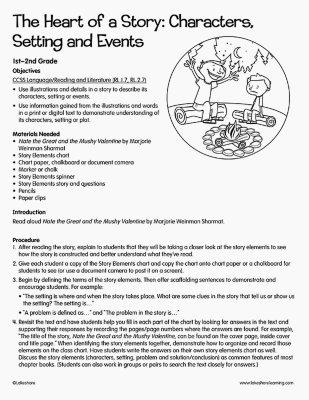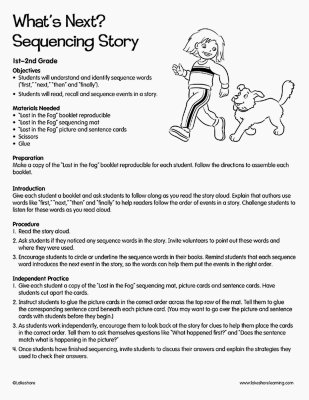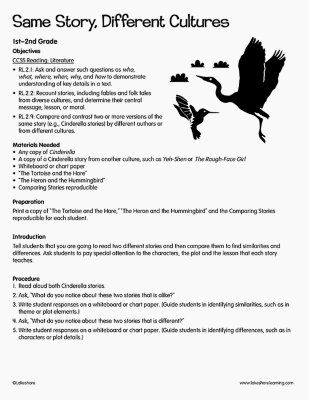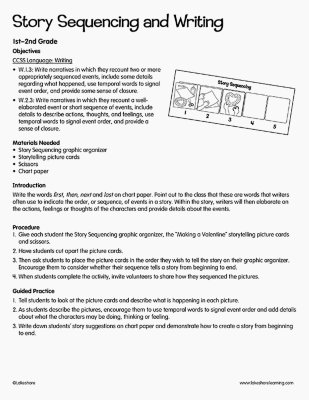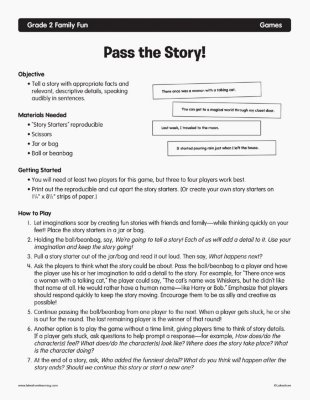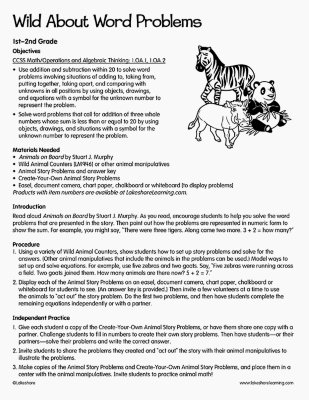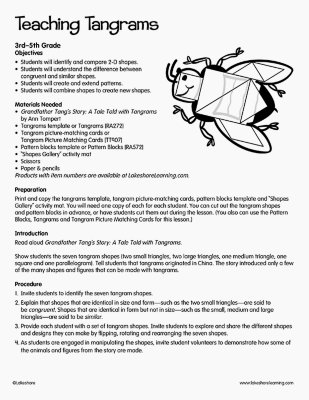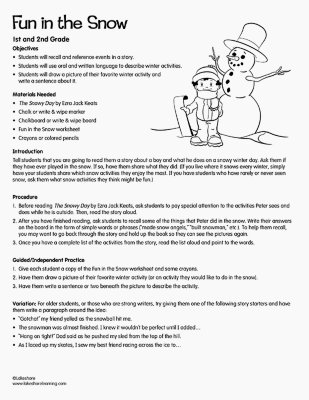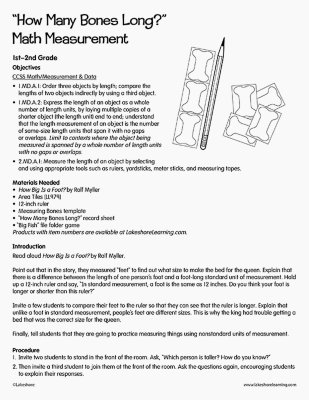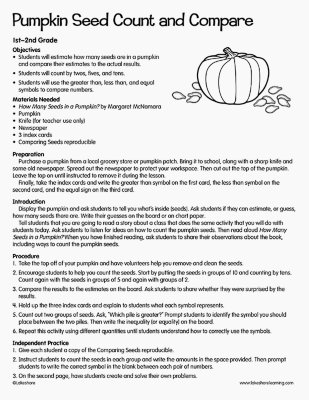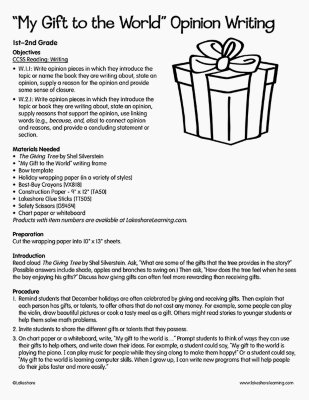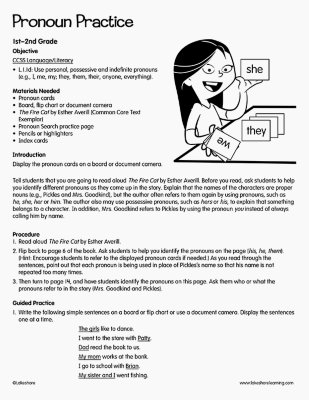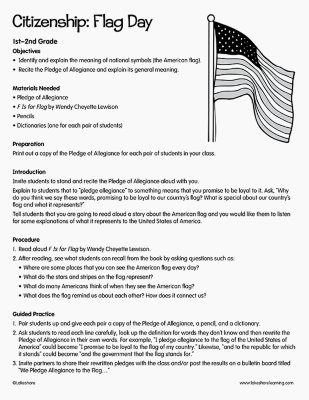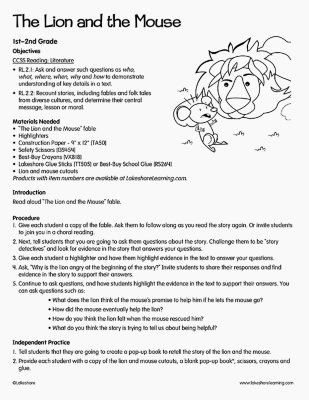Narrow by Grade
- Infant (0)
- Toddler (0)
- Preschool (0)
- Pre-K (0)
- Kindergarten (0)
- 1st (11)
- 2nd (14)
- 3rd (0)
- 4th (0)
- 5th (0)
- 6th & Up (0)
Grade
Narrow by Age
- 0-18m (0)
- 18-36m (1)
- 3 yrs. (0)
- 4 yrs. (11)
- 5 yrs. (13)
- 6 yrs. (21)
- 7 yrs. (14)
- 8 yrs. (15)
- 9 yrs. (14)
- 10 yrs. (6)
- 11 yrs. & Up (0)
Age 7 yrs.
14 results for "story"
Filters
Clear All
The Heart of a Story: Characters, Setting and Events
1st Grade - 2nd Grade
Objectives Using illustrations and details in a story to describe its characters, setting or events Using information from illustrations and words to demonstrate understanding of characters, setting or plot Materials Needed Nate the Great and the Mushy Valentine by Marjorie Weinman Sharmat Story Elements chart Chart paper, chalkboard or document camera Marker or chalk Story Elements spinner Story Elements story and questions Pencils Paper clips Introduction Read aloud Nate the Great and the Mushy Valentine by Marjorie Weinman Sharmat.
View Lesson PlanWhat’s Next? Sequencing Story
1st Grade - 2nd Grade
Objectives Reading Literature Retelling stories and demonstrating understanding of the central message or lesson Describing characters, settings, and major events in a story, using key details Understanding and identifying sequence words (e.g., “first,” “next,” “then,” “finally”) Materials Needed Lost in the Fog booklet reproducible Lost in the Fog sequencing mat Lost in the Fog picture and sentence cards Best-Buy Scissors Lakeshore Glue Sticks Pencils Preparation Make a copy of the Lost in the Fog booklet reproducible, sequencing mat, picture cards and sentence cards for each student. Follow the directions to assemble each booklet. Introduction Give each student a booklet and ask students to follow along as you read the story aloud. Explain that authors use words like “first,” “next,” “then” and “finally” to help readers follow the order of events in a story. Challenge students to listen for these words as you read aloud.
View Lesson PlanSame Story, Different Cultures
1st Grade - 2nd Grade
Objectives CCSS Reading: Literature RL.2.1: Ask and answer such questions as who, what, where, when, why, and how to demonstrate understanding of key details in a text. RL.2.2: Recount stories, including fables and folk tales from diverse cultures, and determine their central message, lesson, or moral. RL.2.9: Compare and contrast two or more versions of the same story (e.g., Cinderella stories) by different authors or from different cultures. Materials Needed Any copy of Cinderella A copy of a Cinderella story from another culture, such as Yeh-Shen or The Rough-Face Girl Whiteboard or chart paper “The Tortoise and the Hare” “The Heron and the Hummingbird” Comparing Stories reproducible Introduction Tell students that you are going to read two different stories and then compare them to find similarities and differences. Ask students to pay special attention to the characters, the plot and the lesson that each story teaches.
View Lesson PlanStory Sequencing and Writing
1st Grade - 2nd Grade
Objectives CCSS Language: Writing W.1.3: Write narratives in which they recount two or more appropriately sequenced events, include some details regarding what happened, use temporal words to signal event order, and provide some sense of closure. W.2.3: Write narratives in which they recount a well-elaborated event or short sequence of events, include details to describe actions, thoughts, and feelings, use temporal words to signal event order, and provide a sense of closure. Materials Needed Story Sequencing graphic organizer Storytelling picture cards Scissors Chart paper Introduction Write the words first, then, next and last on chart paper. Point out to the class that these are words that writers often use to indicate the order, or sequence, of events in a story. Within the story, writers will then elaborate on the actions, feelings or thoughts of the characters and provide details about the events.
View Lesson PlanPass the Story!
2nd Grade
Objective
- Tell a story with appropriate facts and relevant, descriptive details, speaking audibly in sentences.
Wild About Word Problems
1st Grade - 2nd Grade
Objectives CCSS Math/Operations and Algebraic Thinking: 1.OA.1, 1.OA.2 Use addition and subtraction within 20 to solve word problems involving situations of adding to, taking from, putting together, taking apart, and comparing with unknowns in all positions by using objects, drawings, and equations with a symbol for the unknown number to represent the problem. Solve word problems that call for addition of three whole numbers whose sum is less than or equal to 20 by using objects, drawings, and situations with a symbol for the unknown number to represent the problem. Materials Needed Animals on Board by Stuart J. Murphy Wild Animal Counters or other animal manipulatives Animal Story Problems and answer key Create-Your-Own Animal Story Problems Easel, document camera, chart paper, chalkboard or whiteboard [to display problems] Introduction Read aloud Animals on Board by Stuart J. Murphy. As you read, encourage students to help you solve the word problems that are presented in the story. Then point out how the problems are represented in numeric form to show the sum. For example, you might say, “There were three tigers. Along came two more. 3 + 2 = how many?”
View Lesson PlanTeaching Tangrams
2nd Grade
Objectives Students will identify and compare 2-D shapes. Students will understand the difference between congruent and similar shapes. Students will create and extend patterns. Students will combine shapes to create new shapes. Materials Needed Grandfather Tang’s Story: A Tale Told with Tangrams by Ann Tompert Tangrams template or Tangrams Tangram picture-matching cards or Tangram Picture Matching Cards Pattern blocks template or Pattern Blocks “Shapes Gallery” activity mat Scissors Paper & pencils Preparation: Print and copy the tangrams template, tangram picture-matching cards, pattern blocks template and “Shapes Gallery” activity mat. You will need one copy of each for each student. You can cut out the tangram shapes and pattern blocks in advance, or have students cut them out during the lesson. (You also can use the Pattern Blocks, Tangrams and Tangram Picture Matching Cards for this lesson.) Introduction Read aloud Grandfather Tang’s Story: A Tale Told with Tangrams. Show students the seven tangram shapes (two small triangles, two large triangles, one medium triangle, one square and one parallelogram). Tell students that tangrams originated in China. The story introduced only a few of the many shapes and figures that can be made with tangrams.
View Lesson PlanFun in the Snow
1st Grade - 2nd Grade
Objective Students will recall and reference events in a story. Students will use oral and written language to describe winter activities. Students will draw a picture of their favorite winter activity and write a sentence about it. Materials Needed The Snowy Day by Ezra Jack Keats Chalk or write & wipe marker Chalkboard or write & wipe board Fun in the Snow Worksheet Crayons or colored pencils Introduction Tell students that you are going to read them a story about a boy and what he does on a snowy winter day. Ask them if they have ever played in the snow. If so, have them share what they did. (If you live where it snows every winter, simply have your students share which snow activities they enjoy the most. If you have students who have rarely or never seen snow, ask them what snow activities they think might be fun.)
View Lesson Plan"How Many Bones Long?" Math Measurement
1st Grade - 2nd Grade
Objectives CCSS Math/Measurement & Data 1.MD.A.1: Order three objects by length; compare the lengths of two objects indirectly by using a third object. 1.MD.A.2: Express the length of an object as a whole number of length units, by laying multiple copies of a shorter object (the length unit) end to end; understand that the length measurement of an object is the number of same-size length units that span it with no gaps or overlaps. Limit to contexts where the object being measured is spanned by a whole number of length units with no gaps or overlaps. 2.MD.A.1: Measure the length of an object by selecting and using appropriate tools such as rulers, yardsticks, meter sticks, and measuring tapes. Materials Needed How Big Is a Foot? by Rolf Myller Area Tiles 12-inch ruler Measuring Bones template “How Many Bones Long?” record sheet “Big Fish” file folder game Introduction Read aloud How Big Is a Foot? by Rolf Myller. Point out that in the story, they measured “feet” to find out what size to make the bed for the queen. Explain that there is a difference between the length of one person’s foot and a foot-long standard unit of measurement. Hold up a 12-inch ruler and say, “In standard measurement, a foot is the same as 12 inches. Do you think your foot is longer or shorter than this ruler?” Invite a few students to compare their feet to the ruler so that they can see that the ruler is longer. Explain that unlike a foot in standard measurement, people’s feet are different sizes. This is why the king had trouble getting a bed that was the correct size for the queen. Finally, tell students that they are going to practice measuring things using nonstandard units of measurement.
View Lesson PlanPumpkin Seed Count and Compare
1st Grade - 2nd Grade
Objectives Students will estimate how many seeds are in a pumpkin and compare their estimates to the actual results. Students will count by twos, fives, and tens. Students will use the greater than, less than and equal symbols to compare numbers. Materials Needed How Many Seeds in a Pumpkin? by Margaret McNamara Pumpkin Knife (for teacher use only) Newspaper 3 index cards Comparing Seeds reproducible Preparation: Purchase a pumpkin from a local grocery store or pumpkin patch. Bring it to school, along with a sharp knife and some old newspaper. Spread out the newspaper to protect your workspace. Then cut out the top of the pumpkin. Leave the top on until instructed to remove it during the lesson. Finally, take the index cards and write the greater than symbol on the first card, the less than symbol on the second card, and the equal sign on the third card. Introduction Display the pumpkin and ask students to tell you what’s inside (seeds). Ask students if they can estimate, or guess, how many seeds there are. Write their guesses on the board or on chart paper. Tell students that you are going to read a story about a class that does the same activity that you will do with students today. Ask students to listen for ideas on how to count the pumpkin seeds. Then read aloud How Many Seeds in a Pumpkin? When you have finished reading, ask students to share their observations about the book, including ways to count the pumpkin seeds.
View Lesson PlanMy Gift to the World Opinion Writing
1st Grade - 2nd Grade
Objectives CCSS Reading: Writing W.1.1: Write opinion pieces in which they introduce the topic or name the book they are writing about, state an opinion, supply a reason for the opinion and provide some sense of closure. W.2.1: Write opinion pieces in which they introduce the topic or book they are writing about, state an opinion, supply reasons that support the opinion, use linking words (e.g., because, and, also) to connect opinion and reasons, and provide a concluding statement or section. Materials Needed The Giving Tree by Shel Silverstein “My Gift to the World” writing frame Bow template Holiday wrapping paper (in a variety of styles) Best-Buy Crayons Construction Paper - 9" x 12" Lakeshore Glue Sticks Safety Scissors Chart paper or whiteboard Preparation: Cut the wrapping paper into 10" x 13" sheets. Introduction Read The Giving Tree by Shel Silverstein. Ask, “What are some of the gifts that the tree provides in the story?” (Possible answers include shade, apples and branches to swing on.) Then ask, “How does the tree feel when he sees the boy enjoying his gifts?” Discuss how giving gifts can often feel more rewarding than receiving gifts.
View Lesson PlanPronoun Practice
1st Grade - 2nd Grade
Use personal, possessive and indefinite pronouns (e.g., I, me, my, they, them, their, anyone, everything). Materials Needed: pronoun cards, board, flip chart or document camera; The Fire Cat by Esther Averill; Pronoun Search practice page; pencils or highlighters; index cards. Introduction: Display the pronoun cards on a board or document camera. Tell students that you are going to read aloud The Fire Cat by Esther Averill. Before you read, ask students to help you identify different pronouns as they come up in the story. Explain that the names of the characters are proper nouns (e.g., Pickles and Mrs. Goodkind), but the author often refers to them again by using pronouns, such as he, she, her or him. The author also may use possessive pronouns, such as hers or his, to explain that something belongs to a character. In addition, Mrs. Goodkind refers to Pickles by using the pronoun you instead of always calling him by name.
View Lesson PlanCitizenship: Flag Day
2nd Grade
Objectives Identify and explain the meaning of national symbols (the American flag). Recite the Pledge of Allegiance and explain its general meaning. Materials Needed Pledge of Allegiance F Is for Flag by Wendy Cheyette Lewison Pencils Dictionaries (one for each pair of students) Introduction Invite students to stand and recite the Pledge of Allegiance aloud with you. Explain to students that to “pledge allegiance” to something means that you promise to be loyal to it. Ask, “Why do you think we say these words, promising to be loyal to our country’s flag? What is special about our country’s flag and what it represents?” Tell students that you are going to read aloud a story about the American flag and you would like them to listen for some explanations of what it represents to the United States of America.
View Lesson PlanThe Lion and the Mouse
1st Grade - 2nd Grade
Objectives CCSS Reading: Literature RL.2.1: Ask and answer such questions as who, what, where, when, why and how to demonstrate understanding of key details in a text. RL.2.2: Recount stories, including fables and folk tales from diverse cultures, and determine their central message, lesson or moral. Materials Needed “The Lion and the Mouse” fable Highlighters Construction Paper - 9" x 12" Safety Scissors Best-Buy Crayons Lakeshore Glue Sticks or Best-Buy School Glue Lion and mouse cutouts Introduction Read aloud “The Lion and the Mouse” fable.
View Lesson Plan